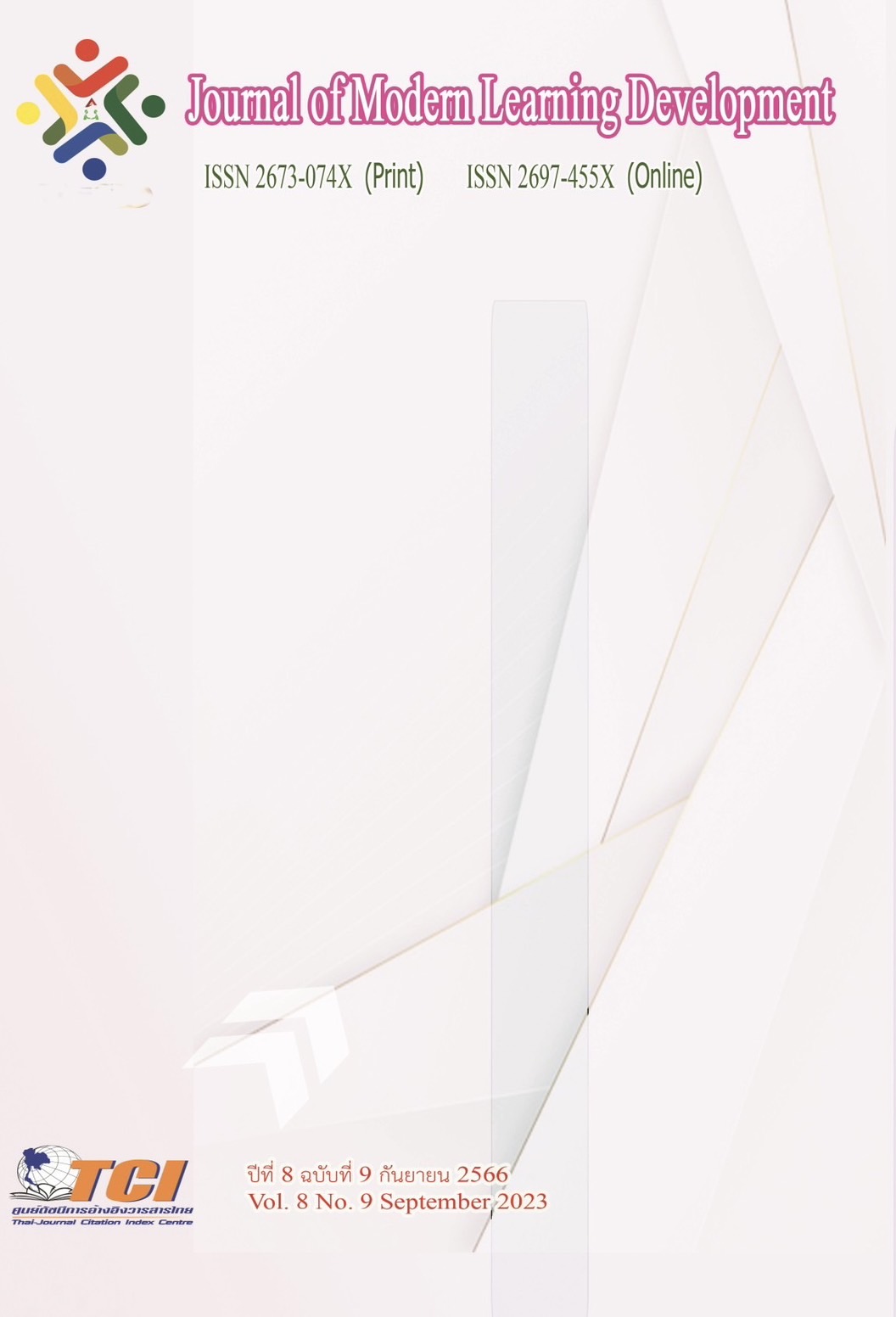Digital Leadership Development Model for Small-Size School Administrator Under Roi-ET Primary Education Service Area Office 1
Main Article Content
Abstract
The objectives of this research were to: 1) Study the components and indicator of digital leadership for school administrator 2) Study of the current state, desirable state, priority needs index of digital leadership for small-size school administrator under Roi-ET primary education service area office 1 3) Create and develop digital leadership development model for small-size school administrator under Roi-ET primary education service area office 1 4) Study the results of the experimental digital leadership development model for small-size school administrator under Roi-ET primary education service area office 1. The research was divided into four phases as follow; phase 1; study the components and indicator of digital leadership for school administrator. The target group of 9 experts to confirm components and indicator. phase 2; study of the current state, desirable state, priority needs index of digital leadership for small-size school administrator. The sample group, consisted 297 administrators and teachers. The research instrument was questionnaire and the data was analyzed using mean, standard deviation phase 3; Create and develop digital leadership development model for small-size school administrator, The target group were 9 experts for create model and 9 experts for confirm and evaluation form of propriety, feasibility, and utility of the model. phase 4; Study the results of the model implementation. The target group of 30 school-size administrators under Roi-ET primary education service area office 1.
The results found that:
1. The components and indicator of digital leadership for school administrator consisted of 4 major, Include 1) new vision and paradigm 2) digital literacy 3) digital communication 4) create and develop innovation.
2. The current state in overall was high average and the desirable state in overall was in the highest level. The need assessment from high to low level was 11) new vision and paradigm 2) digital literacy 3) digital communication 4) create and develop innovation.
3. The component of model, Include 1) principles 2) objectives, 3) content 4) development process 5) measurement and evaluation. The result of evaluation for propriety, feasibility and utility was the highest in overall.
4. The results of the model implementation of digital leadership development model for small-size school administrator under Roi-ET primary education service area office 1. Overall, the average of the items that follow the model were at the highest level and satisfaction at the highest level.
Article Details
References
ชีวิน อ่อนละออ, สุชาติ บางวิเศษ, กานนท์ แสนเภา, สวิตา อ่อนลออ. (2563). ภาวะผู้นำยุคดิจิทัล สำหรับนักบริหารการศึกษา. วารสารวิทยาลัยบัณฑิตเอเซีย. 10 (1), 119-108.
ต้องลักษณ์ บุญธรรม. (2559). การเป็นผู้นํายุคเศรษฐกิจดิจิทัลกับการพัฒนาที่ยั่งยืนขององค์กรทางการศึกษา. วารสารวิชาการครุศาสตร์อุตสาหกรรม พระจอมเกล้าพระนครเหนือ. 7 (1), 217-225.
ทิพวรรณ ล้วนปสิทธิ์สกุล. (2562). คุณลักษณะผู้บริหารสถานศึกษาขั้นพื้นฐานที่สอดคล้องกับเป้าหมายการศึกษาของนโยบายไทยแลนด์ 4.0. วิทยานิพนธ์ปรัชญาดุษฎีบัณฑิต สาขาวิชาการบริหารการศึกษา ภาควิชาการบริหารการศึกษา. บัณฑิตวิทยาลัย: มหาวิทยาลัยศิลปากร.
ธีระ รุญเจริญ. (2550). การบริหารโรงเรียนยุคปฏิรูปการศึกษา. กรุงเทพมหานคร: ธนาเพรส.
ธีระ รุญเจริญ. (2555). การปฏิรูปการบริหาร : แนวคิด ประสบการณ์และการวิจัย. อุบลราชธานี: อุบลกิจออฟเซท.
บุญชม ศรีสะอาด. (2556). การวิจัยเบื้องตน. (พิมพครั้งที่ 9). กรงเทพพมหานคร: สุวิริยาสาสน .
พรรษรัตน์ พรมมินทร์. (2563). การพัฒนารูปแบบภาวะผู้นำของผู้บริหารสถานศึกษาในยุคดิจิทัล สังกัดสำนักงานเขตพื้นที่การศึกษามัธยมศึกษา เขต 5 จังหวัดลพบุรี. ปทุมธานี: มหาวิทยาลัยเวสเทิร์น.
ไพฑูรย์ สินลารัตน์. (2559) (2559). การศึกษา 4.0 เป็นยิ่งกว่าการศึกษา. กรุงเทพมหานคร: โรงพิมพ์แห่งจุฬาลงกรณ์ มหาวิทยาลัย.
วิโรจน์ สารรัตนะ. (2557). ภาวะผู้นำ ทฤษฎี และนานาทัศนะร่วมสมัยปัจจุบัน. กรุงเทพมหานคร: ทิพย์วิสุทธิ์.
วิโรจน์ สารรัตนะ. (2561). ภาวะผู้นำสำหรับศตวรรษที่ 21. วารสารศึกษาศาสตร์ มหาวิทยาลัยนเรศวร. 20 (1),
สมาน อัศวภูมิ. (2550). การใช้วิจัยพัฒนารูปแบบในวิทยานิพนธ์ระดับปริญญาเอก. เอกสารประกอบการสอนวิชาสัมมนาการศึกษาระดับปริญญาเอก. อุบลราชธานี: มหาวิทยาลัยราชภัฏอุบลราชธานี.
สิริกร ไชยราช. (2562). การพัฒนารูปแบบการพัฒนาภาวะผู้นำครูในการจัดการเรียนรู้ตามหลักปรัชญาของเศรษฐกิจพอเพียง ในโรงเรียนมัธยมศึกษา สังกัดสำนักงานศึกษาธิการภาค 11. วิทยานิพนธ์ครุศาสตรดุษฎีบัณฑิต สาขาวิชาการบริหารการศึกษาและภาวะผู้นำ. บัณฑิตวิทยาลัย: มหาวิทยาลัยราชภัฏสกลนคร.
สุกัญญา แช่มช้อย. (2561). การบริหารสถานศึกษาในยุคดิจิทัล. กรุงเทพมหานคร: สำนักพิมพ์ แห่งจุฬาลงกรณ์มหาวิทยาลัย.
สุวิมล ว่องวาณิช. (2558). การวิจัยประเมินความต้องการจำเป็น. กรุงเทพมหานคร: สำนักพิมพ์แห่งจุฬาลงกรณ์มหาวิทยาลัย.
สำนักงานเขตพื้นที่การศึกษาประถมศึกษาร้อยเอ้ด เขต 1. (2564). แผนปฏิบัติราชการ ปีงบประมาณ 2564. ร้อยเอ็ด : กลุ่มนโยบายและแผน.
เอกชัย กี่สุขพันธ์. (2559). การบริหารสถานศึกษายุคดิจิทัล. ออนไลน์. ค้นเมื่อ 15 ธันวาคม 2563. แหล่งที่มา: http://www. trueplookpanya.com/knowledge/content/52232/-edu-t2s1-t2-t2s3-
Eisner, E. (1976). Educational connoisseurship and criticism : Their form and functions in education evaluation. Journal of Aesthetic Education. 39 (2), 192 - 193.
Joyce, B. and Weil, M. and B. Showers. (2011). Models of Teaching. Boston: Allyn and Bacon.
Sheninger, E. C. (2014). Digital leadership : changing paradigms for changing times. United States of America: Corwin.


